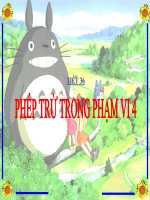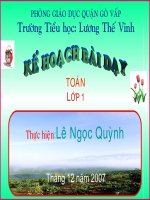Bài giảng Chapter 1 Matter,Measurement, and Problem Solvin
Bạn đang xem bản rút gọn của tài liệu. Xem và tải ngay bản đầy đủ của tài liệu tại đây (5.04 MB, 118 trang )
Chapter 1
Matter,
Measurement,
and Problem
Solving
Chemistry, Julia Burdge, 2
st
Ed.
McGraw Hill.
2011, NKMB Co., Ltd.
Mr. Truong Minh Chien ;
/>
Chemistry, Julia Burdge, 2
nd
e., McGraw Hill.
2
What Is Chemistry?
•
Observation: is sand different than water
•
Test the similarities and differences between
sand and water.
Composition
Types & number of atoms, structure,
Properties
Chemical: how hot, how fast
Physical: size, ability to loose/gain electrons
3
Structure Determines Properties
•
Everything is made of tiny particles called atoms and
molecules.
•
Chemists study these particles, looking at the kinds,
numbers, structure, size which produce varying
chemical and physical properties.
4
The Scientific Method
•
Humans are by nature curious.
•
Have you ever heard a 3 year old repeatedly ask
“why?”
•
Science is just exploring nature.
•
A scientists is just a person exploring.
•
You begin to organize your thoughts into
Observation, you group those observations into
Hypotheses, using Experimentation, and
formulate Laws or Theories.
5
Why Aren’t the Philosophers
Considered Scientists
Philosophers:
•
Observe nature.
•
Explain the behavior of
nature.
•
Communicate and
debate ideas with other
philosophers.
•
Truth is revealed
through logic and
debate.
Scientists:
•
Observe nature.
•
Explain the behavior of
nature.
•
Communicate and debate
ideas with other
scientists.
•
Truth is revealed through
experimentation.
Chemistry, Julia Burdge, 2
nd
e., McGraw Hill.
6
Observation
•
Acquiring information or data
•
Some observations are simple
descriptions
“The soda pop is a liquid with a brown
color and a sweet taste. Bubbles are seen
floating up through it.”
•
Some observations compare a
characteristic.
“A 240-mL serving of soda pop contains
27 g of sugar.”
Chemistry, Julia Burdge, 2
nd
e., McGraw Hill.
7
Hypothesis
•
Looking at your observations you come up
with:
The sweetness of soda pop is due to the presence of
Sugar or
Aluminum
Chemistry, Julia Burdge, 2
nd
e., McGraw Hill.
8
Experiments
•
Test your hypotheses with a taste test: sugar and
aluminum.
Theory
•
Sugar is sweet
Chemistry, Julia Burdge, 2
nd
e., McGraw Hill.
9
Laws
•
Typically a fact of nature, often a math
constant/number and unit.
Law of Conservation of Mass— “In a chemical
reaction matter is neither created nor destroyed.”
Speed of Light, E = mc
2
, Dalton’s Gas Law,
Universal Gas Constant, etc…
•
Unlike California State laws, you cannot
choose to violate a scientific law
Chemistry, Julia Burdge, 2
nd
e., McGraw Hill.
10
Theories
•
Explains how nature behaves.
Newton’s Gravitational Theory: how an apple falls
Dalton’s Atomic Theory: atoms look like…
Darwin’s Theory of Evolution: we always change
Einstein's Theory of Relativity: light is constant
•
Used to predict future observations.
Chemistry, Julia Burdge, 2
nd
e., McGraw Hill.
11
What’s the Difference Between a
Law and a Theory?
•
Laws: Very specific, “What will happen”
often expressed in mathematical equations.
•
Theories: Very general, “Why it will
happen,” often includes many “Laws”
Chemistry, Julia Burdge, 2
nd
e., McGraw Hill.
12
Do we need science?
A history lesson in science
•
A key feature of science are it’s experiments
•
Experiments must be duplicated by other’s!!!
•
Galileo (1564 - 1642) and Newton (1642 -
1727) worked on physics, the first Scientists
•
Lavoisier is first to use the scientific method on
objects/nature on things that could not be
“Seen”
Chemistry, Julia Burdge, 2
nd
e., McGraw Hill.
13
What causes Burning?
Phlogiston Theory
The mid-1700s theory of how wood or coal
burned, referred to as combustion.
•
Wood and coal contained a substances called
phlogiston.
•
When a substance burned it released all or some
of its phlogiston into the air .
14
Problems with Phlogiston Theory
•
When pure metals burn they should weigh
less (turns into calx)…however, metals
always weigh more when burned, that is the
clax always weighed more than the metal.
•
The reverse experiment: If calx is heated, it
should remove phlogiston from the air be
converted back to the metal…however the
Burning Lens experiment by Lavoisier
observed “fixed air” being released back
into the air.
15
The Great Burning Lens: Trying
to Find Phlogiston - ultimately it
was discredited
16
A Better Theory of Combustion
•
Lavoisier purchased the most accurate
scales; scales that would cost over a million
dollars today
•
Lavoisier carefully preformed his
experiments weighing them before and after
each combustion experiment.
Chemistry, Julia Burdge, 2
nd
e., McGraw Hill.
17
A Better Theory of Combustion
Lavoisier proposed an alternative theory of
combustion based on his experiments:
1. When something burns, it can either remove or combine
with “fixed-air.”
2. He discovers Oxygen, hydrogen
Lavoisier literally, rewrites all chemistry textbooks.
Lavoisier’s idea starts modern chemistry based on
reproducible experimentation---backed with very
accurate measurements.
He is executed by a phlogiston believer; political
Lord Kelvin, 1850’s
•
"To measure is to know."
•
"If you can not measure it, you can not improve
it."
18
Chemistry, Julia Burdge, 2
nd
e., McGraw Hill.
19
How to Succeed in Chemistry
•
Curiosity and your
imagination are your allies
Explore and investigate.
•
Quantify and calculate
Even small differences can be
important!
•
Commitment
Work regularly and carefully.
Chemistry, Julia Burdge, 2
nd
e., McGraw Hill.
20
The Best Approach to
Learning Chemistry
•
Learn the vocabulary of chemistry.
Definitions and terms.
How common vocabulary is applied to chemistry.
•
Memorize important information.
Names, formulas, and charges of polyatomic ions.
Solubility rules.
•
Learn and practice processes.
Systematic names and formulas.
Dimensional analysis.
•
Do the questions and exercises in the chapter to test
your understanding and help you learn the patterns?
Chemistry, Julia Burdge, 2
nd
e., McGraw Hill.
Classification of Matter
States of Matter
Physical and Chemical Properties
Physical and Chemical Changes
A Molecular Approach 23
Classification of Matter
•
matter is anything that has mass and occupies
space,
•
Light, music, microwaves are not matter
•
we can classify matter based on whether it’s
solid, liquid, or gas
25
Solids
•
the particles in a solid are packed close
together and are fixed in position
though they may vibrate
•
the close packing of the particles results
in solids being incompressible
•
the inability of the particles to move
around results in solids retaining their
shape and volume when placed in a new
container, and prevents the particles from
flowing
Chemistry, Julia Burdge, 2
nd
e., McGraw Hill.
26
Crystalline Solids
•
some solids have their
particles arranged in an
orderly geometric pattern –
we call these crystalline
solids
salt and diamonds
Chemistry, Julia Burdge, 2
nd
e., McGraw Hill.
27
Amorphous Solids
•
some solids have their
particles randomly
distributed without any
long-range pattern – we call
these amorphous solids
plastic
glass
charcoal
Chemistry, Julia Burdge, 2
nd
e., McGraw Hill.


![CACH CHEN CAC DOI TUONG VAO BAI GIANG powerpoint[1]](https://media.store123doc.com/images/document/13/gu/fo/medium_foa1373594548.jpg)






